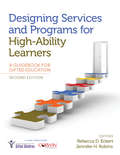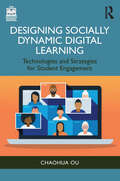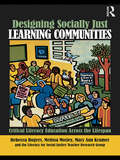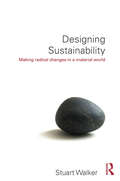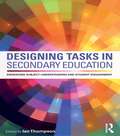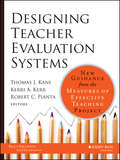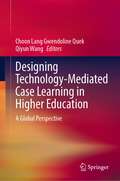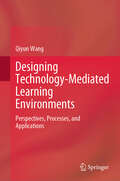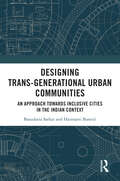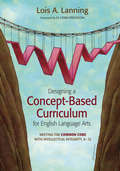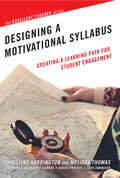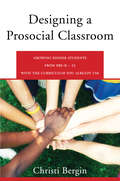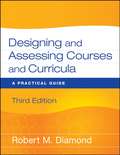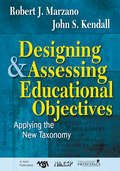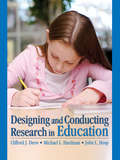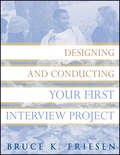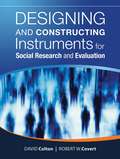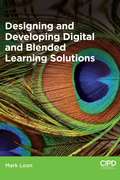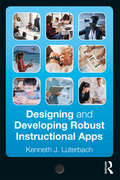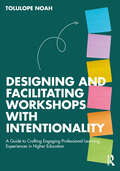- Table View
- List View
Designing Services and Programs for High-Ability Learners: A Guidebook for Gifted Education
by Rebecca D. Eckert Jennifer H. RobinsThe updated, comprehensive guide to developing or enhancing gifted programming With new perspectives based on recent research and the updated National Association for Gifted Children Programming Standards, this second edition of Designing Services and Programs for High-Ability Learners provides educators with the comprehensive, practical advice they need to support today’s gifted learners. Written by leading experts, each chapter focuses on a key feature of high-quality gifted programs and takes into account current educational trends, such as the Focus on diversity to ensure underrepresented populations are screened for gifted education Collaboration with special education to ensure students with disabilities have access to programming Use of technology Development of local policies to support gifted education
Designing Socially Dynamic Digital Learning: Technologies and Strategies for Student Engagement
by Chaohua OuDesigning Socially Dynamic Digital Learning is a practical guide to the creation of online and blended coursework and learning environments that foster social interaction and engagement among students. Regardless of format, enrollees in higher education need active, collaborative, and social experiences to thrive, though new guidance is needed to help faculty and administrators integrate digital tools and develop courses toward this goal. This book introduces state-of-the-art learning technologies and evidence-based pedagogical strategies that can be seamlessly adopted and adapted across disciplines. Instructors, learning designers, consultants, and educational technology trainers, developers, and directors will find a wealth of fresh insights and best practices as they select, apply, and incentivize digital technologies for social-forward yet outcomes-driven learning experiences.
Designing Socially Just Learning Communities: Critical Literacy Education across the Lifespan
by Rebecca Rogers Mary Ann Kramer Melissa Mosley The Literacy for Social Justice Teacher Research GroupDemonstrating the power and potential of educators working together to use literacy practices that make changes in people's lives, this collaboratively written book blends the voices of participants in a teacher-led professional development group to provide a truly lifespan perspective on designing critical literacy practices. It joins these educators’ stories with the history and practices of the group - K-12 classroom teachers, adult educators, university professors, and community activists who have worked together since 2001 to better understand the relationship between literacy and social justice. Exploring issues such as gender equity, linguistic diversity, civil rights and freedom and war, the book showcases teachers’ reflective practice in action and offers insight into the possibilities and struggles of teaching literacy through a framework of social justice. Designing Socially Just Learning Communities models an innovative form of professional development for educators and researchers who are seeking ways to transform educational practices. The teachers' practices and actions – in their classrooms and as members of the teacher research group – will speak loudly to policy-makers, researchers, and activists who wish to work alongside them.
Designing Spatial Culture
by Roderick AdamsDesigning Spatial Culture investigates a powerful experiential dialogue formed between the habitation of space and a diversified cultural realm. This creative proposition binds and positions human activity and experience framing its histories, currency and future. Whilst the book distinguishes between the conditions of the existing urban/ architecture/ interior canon, it embraces a new agency of space, showcasing the encounters, assemblies and designs that shape human behaviours and the cultural forms of the built environment. Using authoritative case studies, the book examines many locations and spaces, ranging from new urban landscapes, historical domestic spaces and contemporary architecture. It embraces the most lavish and flamboyant to the most simplistic and minimal, establishing a connected cultural narrative. The book shifts the focus in the spatial realm from an object-based experience (where space is filled with things) to a more complete immersive experience (combining physical and digital). A key part of this exploration is the relationship between the architecture and the interior which is often the most predominant spatial experience and fundamental to the understanding spatial experience and existing cultures. Without the architectural enclosure, the interior would lose its site context and structure for its existence. Without an interior, architecture would not fully develop an engaging spatial experience for the user. The book rationalises this through extended use of a spatial probe which documents and summarises an evidence-based research project capturing spatial culture data from a predominantly domestic setting. The book is essential reading for students and researchers in architecture, interior design and urban design.
Designing Sustainability: Making radical changes in a material world
by Stuart WalkerWhat is the relationship between design, sustainability, inner values and spirituality? How can we create designs that provide a convincing alternative to unsustainable interpretations of progress, growth, consumerism and commercialism? Building on the arguments first advanced in his widely acclaimed books Sustainable by Design and The Spirit of Design, Stuart Walker explains how we can achieve the systemic changes needed to address the challenges of sustainability. Challenging common assumptions about the nature of our contemporary material culture and its relationship to human flourishing, the author introduces approaches to design that draw inspiration from nature, summon the human imagination and create outcomes which are environmentally responsible and socially just, as well as meaningful and enriching at a personal level. Offering a unique and original contribution to this vital debate, Designing Sustainability is destined to become essential reading for students on courses in design and sustainability and for design practitioners looking for a deeper, more meaningful basis for their work.
Designing Tasks in Secondary Education: Enhancing subject understanding and student engagement
by Ian ThompsonEngaging students in learning about their subject is a central concern for all teachers and teacher educators. How teachers view and use the pedagogic potential of different tasks to engage pupils with knowledge in different subjects, is central to this endeavour. Designing Tasks in Secondary Education explores models for effective task design, helping you translate the curriculum into the tasks and activities that you ask your students to do in order to facilitate developmental or higher-level understanding of curriculum content. Written by experts in the field of education from a range of subjects and including a foreword written by renowned author Professor Walter Doyle, this book spans an international context and offers a refreshing alternative of how to plan and design tasks that will not only intellectually stimulate but improve teaching quality. Key topics explored include: Designing tasks which engage learners with knowledge Policy perspectives on task design Designing cognitively demanding classroom tasks Task design issues in the secondary subjects Designing Tasks in Secondary Education offers essential insight into task design and its importance for enhancing subject understanding and student engagement. It will challenge and support all education professionals concerned with issues of curriculum design, subject knowledge, classroom organisation, agency in the learning process and teaching quality.
Designing Teacher Evaluation Systems
by Thomas Kane Robert Pianta Kerri KerrDefinitive research for meaningful teacher evaluationsAll across America, in urban, suburban, and rural schools, teacher evaluation procedures are much-debated. Evaluation processes for teachers have varied over the years, and the usefulness of those processes to improve and assess the quality of a teacher's instruction has been questionable and often non-existent. Designing Teacher Evaluation Systems, New Guidance from the Measures of Effective Teaching Project provides you with original research from an extensive study that will help you rethink and redesign teacher evaluation procedures.Using the MET data set, Designing Teacher Evaluation Systems addresses the top questions of practitioners who are involved in designing reliable and useful teacher evaluations. Former teacher assessments were not effective in identifying poor performers from good performers. This book offers you new guidance to build evaluation programs that will fairly and accurately evaluate teaching practices employed by your instructors. It will also:Share information from some of the leading thinkers in K-12 educationCover over three years of definitive research in the field of teacher evaluationHelp you develop and employ effective evaluation processesInstruct and guide future leaders in educationFilled with a rich supply of valuable information from MET researchers around the country, Designing Teacher Evaluation Systems is a thorough collection that equips you to devise and implement a teacher evaluation procedure that will enhance your teachers' performance and improve your students' achievement levels. This book shows how teacher evaluations can become meaningful assessments used to bolster educational excellence for teachers and students.
Designing Technology-Mediated Case Learning in Higher Education: A Global Perspective
by Choon Lang Gwendoline Quek Qiyun WangThis book collects case studies in design and application of technology-mediated case-based learning models in higher education. It provides a much-needed, updated synthesis of recent research and application of technology-mediated case-based learning across disciplines within higher education. The book does not only provide a broad perspective and deep understanding on the designs and instructional applications of technology-mediated case-based learning models, but also inspire more interest in adopting or inventing new situated case-based learning models in the context of higher education.
Designing Technology-Mediated Learning Environments: Perspectives, Processes, and Applications
by Qiyun WangThis book helps teacher designers better understand the roles of technology in education, the key design perspectives of a technology-mediated learning environment (TMLE), the design considerations for each perspective, and the design processes of a TMLE. This book presents a generic conceptual framework, called Pedagogical, Social and Technical design (PST), to illustrate the main design perspectives of the TMLE and their relationship. It also describes a pragmatic design approach, the educational design research approach, for teacher designers to easily follow when they are designing TMLEs. This book also demonstrates two application examples using the PST framework as a design tool to design a blended synchronous learning environment and as an analytical tool to evaluate the educational affordances of an information and communication technology tool.
Designing Trans-Generational Urban Communities: An Approach towards Inclusive Cities in the Indian Context
by Basudatta Sarkar Haimanti BanerjiThis book examines the inclusiveness of city planning and design to address gaps in policies, strategies and design guidelines for developing trans-generational urban communities in India. Identifying key factors and measurable indicators of trans-generational cities within social, physical, and economic dimensions, the volume highlights the need for establishing age-friendly and child-friendly cities and communities. Through a systematic process of ground data collection, the book explores issues related to health, daily routine, lifestyle, recreation, and socialization within vulnerable groups, considering their physical and cognitive limitations for framing adaptable policies. The volume integrates a bottom-up and top-down approach by integrating the needs and perception of the target group obtained from extensive groundwork with the available theories and literature in allied fields adopting a step-by step synchronized methodology. It also presents the way forward for framing policies focusing on socio-economic security, participation, dignity, care, and self-fulfillment.Offering rich empirical research, this book will be useful for students, teachers and researchers of architecture, urban design, urban geography, urban studies, urban development and planning, and child psychology. It will also be of interest to urban planners and designers, policy planners, local government authorities and professionals engaged in the discipline.
Designing Transformative Experiences: A Toolkit for Leaders, Trainers, Teachers, and other Experience Designers
by Brad McLainOffering a new lens on leadership and living, this research-based guide shows how to design experiences that can touch hearts, provoke minds, and change lives in powerful ways.Transformative experiences are life events that change our sense of self in important ways. How do they work? What elements do they require? How can we learn to design them intentionally?By embracing the research-based approach of ELVIS (the Experiential Learning Variables and Indicators System), this book details how to recast yourself as an Experience Design Leader, one that can provide those in your organization with the opportunities needed to reflect and grow as individuals.Beginning with the ELVIS Framework, you will gain deep foundational insight into how transformative experiences work. And then with the ELVIS Toolkit, which includes seven practical design elements, you will have the key to unlocking these powerful experiences for yourself and others.Whether you are new to the idea of designing experiences for others or are a seasoned veteran, ELVIS shows you how to tap into the psychology operating behind the most powerful and important experiences of our lives-those that shape who we are.
Designing Transformative Multicultural Initiatives: Theoretical Foundations, Practical Applications, and Facilitator Considerations
by Marybeth GasmanHigher education is facing a perfect storm as it contends with changing demographics, shrinking budgets and concerns about access and cost, while underrepresented groups – both in faculty ranks and students – are voicing dissatisfaction with campus climate and demanding changes to structural inequities.This book argues that, to address the inexorable changes ahead, colleges and universities need both to centralize the value of diversity and inclusion and employ a set of strategies that are enacted at all levels of their institutions. It argues that individual and institutional change efforts can only be achieved by implementing “diversity as a value” – that is embracing social change efforts as central and additive rather than episodic and required – and provides the research and theoretical frameworks to support this approach, as well as tools and examples of practice that accomplish change.The contributors to this book identify the elements that drive successful multicultural initiatives and that strengthen the effectiveness of campus efforts to dismantle systemic oppression, as well as the individual and organization skills needed to manage difference effectively. Among these is developing the capacity of administrators, faculty and student affairs professionals as conscious scholar practitioners to sensitively manage conflicts on campus, deconstruct challenging structures and reconstruct the environment intentionally to include in respectful ways experiences of historically marginalized groups and non-dominant ways of being in the world. The books’ focus on developing capacities for multicultural competence aligns with higher education’s increasing emphasis on civic engagement and institutional goals promote skills to interact in meaningful and responsible ways around difference, whether of people, ideas or identities.Designing Transformative Multicultural Initiatives provides guiding principles and practical strategies to successfully transform higher education to become fully inclusive and advance the success of all constituents and stakeholders.
Designing Video and Multimedia for Open and Flexible Learning (Open and Flexible Learning Series)
by Jack KoumiThis is a comprehensive, practical guide to the most effective use of video and multimedia in open and distance learning. Illustrated throughout, it considers pedagogic design principles for the highest quality learning material, covering: what to teach on video and how to teach it when to choose and how to use other media for teaching a framework of pedagogic design principles for video and multimedia practical development advice for interactive multimedia. With insights into the comprehensive process of designing, developing and managing distance learning materials, this book will appeal to those involved in course development, educational video, audiovision and interactive multimedia design, as well as to students of general video and multimedia production.
Designing With Color: Concepts And Applications
by J. R. Watson Chris DoroszThis textbook/workbook trains students' eyes to develop a visual understanding of color and the principles of design through guided observation and engaging activities. Lavishly illustrated with full-color graphics and photos, the book demonstrates how color and other design elements are combined in nature and the visual arts. Part One presents color, the most immediately noticeable element of design. Part Two integrates color with the other design elements and shows how they interact according to the principles of design. Students can apply their learning by completing a series of activities and record their work with photos for future reference.
Designing a Concept-Based Curriculum for English Language Arts: Meeting the Common Core With Intellectual Integrity, K–12
by Lois A. LanningHow to ensure your ELA teaching sticks How can you teach for understanding and meet Common Core standards at the same time? The answer: with a concept-based curriculum. Fusing Lynn Erickson's groundbreaking curriculum model with implementation guidelines and sample units, this book puts you on the fast track to using concept-based curriculum in your school or district. Lanning shows you how to design a curriculum that: Functions as a framework for lesson plans Unites the efforts of ELA teachers district-wide Addresses core standards while focusing on student understanding Creates a ripple effect helping to align curriculum, assessments, and instruction
Designing a Motivational Syllabus: Creating a Learning Path for Student Engagement
by Christine Harrington Melissa ThomasA thoughtfully constructed syllabus can be transformative for your students’ learning, communicating the path they can take to succeed. This book demonstrates how, rather than being a mundane document to convey policies, you can construct your syllabus to be a motivating resource that conveys a clear sense of your course’s learning goals, how students can achieve those goals, and makes evident your teaching philosophy and why you have adopted the teaching strategies you will use, such as discussion or group activities. Developing or revising a syllabus also presents you with a perfect opportunity to review the learning possibilities for the semester. Well-designed, it can help you stay focused on achieving the learning outcomes, as well as determine if the class is on track and whether adjustments to the schedule are needed. The authors show how, by adopting a welcoming tone and clearly stating learning outcomes, your syllabus can engage students by explaining the relevance of your course to their studies, create an all-important positive first impression of you as an instructor, and guide students through the resources you will be using, the assignments ahead, as well as clear guidance on how they will be assessed. Referred to frequently as the course progresses, an effective syllabus will keep students engaged and on task.Christine Harrington and Melissa Thomas lead you through all the elements of a syllabus to help you identify how to present key messages and information about your course, think through the impressions you want to create, and, equally importantly, suggest how you can use layout and elements such as images and charts to make your syllabus visually appealing and easy to navigate.
Designing a Prosocial Classroom: Fostering Collaboration In Students From Prek-12 With The Curriculum You Already Use
by Christi BerginA practical how-to guide for promoting positive classroom cultures. A prosocial classroom is easy to spot! Students are engaged in learning, have a warm relationship with the teacher, and can collaborate smoothly; conflicts and behavioral problems are the exception rather than the rule. Not only are students happier in this kind of positive environment, their academic achievement improves. But it's far from obvious how to establish and maintain such a productive and peaceful classroom. In Designing a Prosocial Classroom, Christi Bergin has distilled the complex literature about social-emotional learning into a set of tools that all teachers can use to promote prosocial behavior. As with any skill, fostering kindness and collaboration requires deliberate practice; but it does not require a separate curriculum. These research-based tools—using effective discipline, building prosocial habits, developing positive relationships, modeling good coping strategies—are teaching practices that can be employed within any content area during regular instruction. Each chapter includes authentic classroom vignettes, highlights from the research on prosocial behavior, and questions for reflection and discussion. Designing a Prosocial Classroom is an engaging read and an ideal resource for a school-wide book study group; included in an appendix is a case study for review and discussion of the teaching tools presented in the chapters.
Designing and Assessing Courses and Curricula
by Diamond Robert M.Designing and Assessing Courses and Curricula reflects the most current knowledge and practice in course and curriculum design and connects this knowledge with the critical task of assessing learning outcomes at both course and curricular levels. This thoroughly revised and expanded third edition of the best-selling book positions course design as a tool for educational change and contains a wealth of new material including new chapters, case examples, and resources.
Designing and Assessing Educational Objectives: Applying the New Taxonomy
by Robert J. Marzano John S. KendallEducators across grade levels and content areas can apply the concepts of Marzano's New Taxonomy to turn standards into concrete objectives and assessments to measure student learning.
Designing and Conducting Research in Education
by Dr Clifford J. Drew Michael L Hardman John L. Hosp"The authors did an excellent job of engaging students by being empathetic to their anxieties while taking a research design course. The authors also present a convincing case of the relevancies of research in daily life by showing how information was used or misused to affect our personal and professional decisions." —Cherng-Jyh Yen, George Washington University A practice-oriented, non-mathematical approach to understanding, planning, conducting, and interpreting research in educationPractical and applied, Designing and Conducting Research in Education is the perfect first step for students who will be consuming research as well as for those who will be actively involved in conducting research. Readers will find up-to-date examinations of quantitative, qualitative, and mixed-methods research approaches which have emerged as important components in the toolbox of educational research. Real-world situations are presented in each chapter taking the reader through various challenges often encountered in the world of educational research. Key Features:Examines quantitative, qualitative, and mixed-methods research approaches, which have emerged as important components in the toolbox of educational researchExplains each step of the research process very practically to help students plan and conduct a research project in educationApplies research in real-world situations by taking the reader through various challenges often encountered in field settings Includes a chapter on ethical issues in conducting researchProvides a Student study site that offers the opportunity to interact with contemporary research articles in educationInstructor Resources on CD provide a Computerized test bank, Sample Syllabi, General Teaching Tips and moreIntended audience: This book provides an introduction to research that emphasizes the fundamental concepts of planning and design. The book is designed to be a core text for the very first course on research methods. In some fields the first course is offered at an undergraduate level whereas in others it is a beginning graduate class."The book is perfect for introductory students. The language is top notch, the examples are helpful, and the graphic features (tables, figures) are uncomplicated and contain important information in an easy-to-understand format. Excellent text!" —John Huss, Northern Kentucky University "Designing and Conducting Research in Education is written in a style that is conducive to learning for the type of graduate students we teach here in the College of Education. I appreciate the 'friendly' tone and concise writing that the authors utilize." —Steven Harris, Tarleton State University"A hands on, truly accessible text on how to design and conduct research" —Joan P. Sebastian, National University
Designing and Conducting Your First Interview Project
by Bruce K. FriesenDesigning and Conducting Your First Interview ProjectUsing a clear, easily followed approach, Designing and Conducting Your First Interview Project helps anyone new to the process develop the skills to conduct the most essential part of social research data collection: the interview. The book also shows how to organize, analyze, and interpret the data. This workbook provides a step-by-step template for a collaborative class experience in social science. Organized according to the steps of the deductive scientific method, it includes essential activities to take place during class after the appropriate chapter has been read. The book begins with the process of choosing a topic and proceeds through hypothesis development, interview data collection, data entry using SPSS, and elementary data analysis. The final chapter includes the formal assignment and instructions to students on how to write about their experiences in a way that will produce an excellent final paper. By selecting the hypothesis, gathering the data, and analyzing the results, students will gain an appreciation for the strengths and potential weaknesses of "knowing" things through doing quantitative social science.
Designing and Constructing Instruments for Social Research and Evaluation
by David Colton Robert W. CovertWritten in easy-to-understand language, this important text provides a systematic and commonsense approach to developing instruments for data collection and analysis. This book can be used by both those who are developing instruments for the first time and those who want to hone their skills, including students, agency personnel, program managers, and researchers. This book provides a thorough presentation of instrument construction, from conception to development and pre-testing of items, formatting the instrument, administration, and, finally, data management and presentation of the findings. Throughout the book, the authors emphasize how to create an instrument that will produce trustworthy and accurate data. To that end they have included guidelines for reviewing and revising the questionnaire to enhance validity and reliability. They also show how to work effectively with stakeholders such as instruments designers, decision-makers, agency personnel, clients, and raters or respondents.
Designing and Developing Digital and Blended Learning Solutions
by Mark LoonDesigning and Developing Digital and Blended Learning Solutions is essential reading for anyone studying the Level 5 CIPD L&D module of the same name as well as all learning and development professionals looking to understand the growing role of technology in L&D. Covering both current and emerging learning technologies, this book will help readers assess which technologies are right for their needs. It also covers how to design blended learning solutions, how to develop digital learning content as well as how to evaluate the effectiveness of this digital content. Most importantly, Designing and Developing Digital and Blended Learning Solutions provides guidance on how to implement digital and blended learning solutions including identifying the appropriate platforms and the roles, tools and processes needed to support effective implementation. Full of practical examples and advice, this is an invaluable guide for students and practitioners alike.
Designing and Developing Robust Instructional Apps
by Kenneth J. LuterbachDesigning and Developing Robust Instructional Apps advances the state of instructional app development using three learning paradigms for building knowledge foundations, problem-solving, and experimentation. Drawing on research and development lessons gleaned?from noted educational technologists, time-tested systematic instructional design processes, and results from user experience design, the book considers the planning and specification of instructional apps that blend media (text, images, sound, and moving pictures) and instructional method. Further, for readers with little to no programming experience, introductory treatments of JavaScript and Python, along with data fundamentals and machine learning techniques, offer a guided journey that produces robust instructional apps and?concludes with next steps for advancing the state of instructional app development.
Designing and Facilitating Workshops with Intentionality: A Guide to Crafting Engaging Professional Learning Experiences in Higher Education
by Tolulope NoahDesigning and Facilitating Workshops with Intentionality offers practical guidance, tools, and resources to assist practitioners in creating effective, engaging workshops for adult learners.Drawing from three key learning frameworks and the author’s considerable expertise in facilitating workshops across both educational and corporate settings, this book focuses on ten essential principles to consider when developing professional learning experiences. Whether facilitating on-site or virtually, readers will gain a deeper understanding of how to design and facilitate workshops with an inclusive mindset, thus creating meaningful, active learning opportunities that result in greater involvement among participants and better feedback. Guiding questions, chapter takeaways, and a compendium of additional online resources supply plentiful opportunities to further build and fine-tune these skills.Within these pages, both new and seasoned facilitators will find inspiration, encouragement, and support, as they craft professional learning experiences that ignite curiosity and spark growth in all learners.
